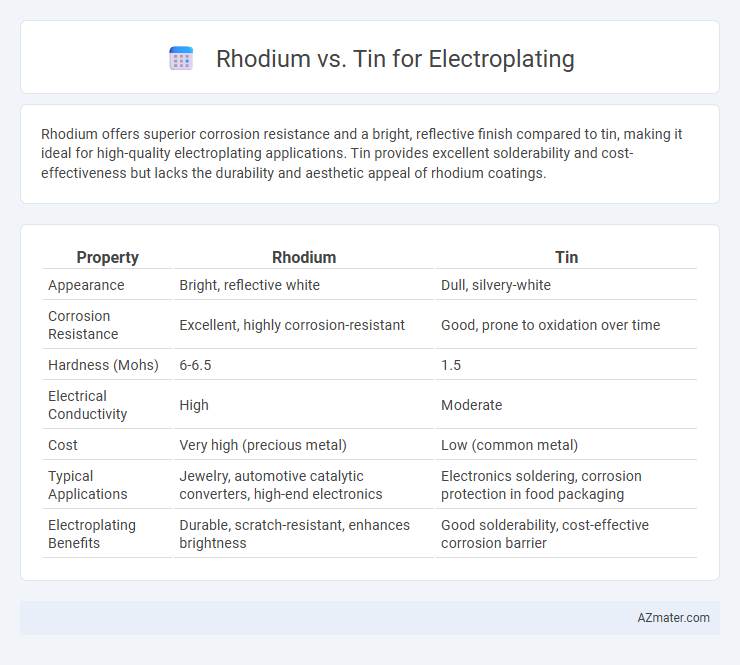Rhodium offers superior corrosion resistance and a bright, reflective finish compared to tin, making it ideal for high-quality electroplating applications. Tin provides excellent solderability and cost-effectiveness but lacks the durability and aesthetic appeal of rhodium coatings.
Table of Comparison
| Property | Rhodium | Tin |
|---|---|---|
| Appearance | Bright, reflective white | Dull, silvery-white |
| Corrosion Resistance | Excellent, highly corrosion-resistant | Good, prone to oxidation over time |
| Hardness (Mohs) | 6-6.5 | 1.5 |
| Electrical Conductivity | High | Moderate |
| Cost | Very high (precious metal) | Low (common metal) |
| Typical Applications | Jewelry, automotive catalytic converters, high-end electronics | Electronics soldering, corrosion protection in food packaging |
| Electroplating Benefits | Durable, scratch-resistant, enhances brightness | Good solderability, cost-effective corrosion barrier |
Introduction to Electroplating
Electroplating is a process where a metal coating is deposited onto a substrate through an electric current, enhancing corrosion resistance, appearance, and surface hardness. Rhodium electroplating provides a bright, reflective finish with excellent hardness and superior resistance to tarnishing, making it ideal for high-end jewelry and automotive parts. Tin electroplating offers cost-effective corrosion protection and solderability, commonly used in electronics and food packaging applications.
Overview of Rhodium and Tin as Plating Materials
Rhodium is a precious metal known for its exceptional hardness, corrosion resistance, and brilliant reflective finish, making it ideal for high-end jewelry and electronic components. Tin, a more economical option, offers good solderability and corrosion resistance, commonly used in electronics and food packaging applications. Both metals provide protective coatings, with rhodium favored for superior durability and aesthetic appeal, while tin excels in cost-effectiveness and electrical conductivity.
Chemical Properties: Rhodium vs Tin
Rhodium exhibits exceptional chemical stability and resistance to oxidation, making it ideal for durable electroplating applications requiring corrosion protection and high reflectivity. Tin, while offering good conductivity and solderability, is more prone to oxidation and tarnishing, which can limit its long-term chemical resistance. The distinct electrochemical potentials of rhodium (+0.76 V) and tin (-0.14 V) influence their plating behavior, with rhodium providing superior hardness and chemical inertness compared to tin's softer and more reactive surface.
Visual Appearance and Finish
Rhodium electroplating delivers a brilliant, mirror-like finish with exceptional hardness, providing a highly reflective silver-white appearance that resists tarnishing and scratches, making it ideal for high-end jewelry and luxury items. Tin plating offers a duller matte or semi-bright finish with moderate corrosion resistance, often used for functional and industrial applications rather than aesthetic appeal. Rhodium's superior brightness and durability give it a premium visual advantage over tin, which is preferred for cost-effective, utilitarian coatings.
Durability and Wear Resistance
Rhodium offers superior durability and wear resistance compared to tin, making it ideal for high-performance electroplating applications that require long-lasting protection. Its hardness and resistance to tarnish ensure extended lifespan and minimal maintenance, especially in jewelry and electronics industries. Tin, while providing good corrosion resistance, tends to wear faster under mechanical stress, limiting its use in environments demanding heavy abrasion resistance.
Corrosion and Tarnish Resistance
Rhodium electroplating offers superior corrosion and tarnish resistance compared to tin, making it ideal for high-durability applications. Rhodium's dense, inert surface prevents oxidation and maintains a bright, reflective finish over time, while tin plating is more prone to forming a dull oxide layer and corrodes faster under harsh environmental conditions. For components exposed to moisture and chemicals, rhodium plating ensures enhanced longevity and minimal maintenance due to its exceptional protective properties.
Cost Comparison: Rhodium vs Tin
Rhodium electroplating is significantly more expensive than tin due to rhodium's rarity and its high demand in automotive and jewelry industries, with costs often reaching several hundred dollars per ounce. Tin plating remains a cost-effective choice for electronics and packaging industries, priced substantially lower because of its abundance and ease of application. The price disparity makes tin the preferred option for large-scale, budget-sensitive projects, while rhodium plating is reserved for high-value items requiring superior corrosion resistance and a bright, reflective finish.
Common Applications in Industry
Rhodium electroplating is widely used in the automotive and jewelry industries for its exceptional corrosion resistance, high reflectivity, and hardness, which enhances durability and aesthetic appeal. Tin electroplating, commonly applied in the electronics and food packaging sectors, provides excellent solderability, moisture resistance, and is an economical choice for preventing metal corrosion. Both metals serve critical roles in enhancing surface properties, yet rhodium is preferred for premium, high-wear applications, while tin is favored for cost-effective, functional coatings.
Environmental and Safety Considerations
Rhodium electroplating offers superior corrosion resistance and long-lasting finishes but involves toxic plating solutions containing hexavalent chromium or organic solvents requiring strict handling protocols to minimize environmental impact. Tin plating is more environmentally friendly, using less hazardous chemicals and simpler waste management, making it preferable for applications with stringent ecological regulations. Proper disposal methods and protective equipment are essential for both metals to ensure worker safety and reduce harmful emissions during electroplating processes.
Choosing the Right Metal for Your Electroplating Needs
Rhodium offers superior corrosion resistance, high reflectivity, and excellent hardness, making it ideal for jewelry and high-end electronic components requiring durable, bright finishes. Tin provides cost-effective protection, good solderability, and anti-corrosive properties, commonly used in food packaging and electrical connectors. Selecting the right metal depends on factors like budget, desired appearance, environmental exposure, and mechanical requirements of the electroplated item.

Infographic: Rhodium vs Tin for Electroplating
 azmater.com
azmater.com